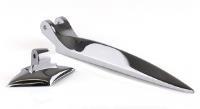 Add My Company
Add My Company
Sign In
A Brief Guide to Chrome Plating
26-05-2018

Chrome plating is the process of electroplating a thin layer of chrome onto a metal or plastic object for decorative or practical purposes. Dorsetware are one of the leading suppliers of chrome plating in Hampshire and BSI certified, serving the metal needs of customers since 1969 and skilled in chrome plating services.
What is Chrome?
Chrome is a metal and one of the naturally occurring chemical elements, otherwise known as Chromium. Chrome in its solid form is not practical but the properties it contains are valuable when layered on other metals such as aluminium, stainless steel, brass, copper or plastic.
Chrome is often confused with other chemicals that give a shiny finish, like polished aluminium and electro polished stainless steel. Chrome plating is brighter, bluer and more mirror-like that creates an accurate reflection compared to other finishes.
What is chrome plating used for?
Chrome plating is used to provide increased corrosion resistance, surface hardness, to ease the maintenance process of the metal or for purely decorative purposes.
How is a chrome plating applied?
Chrome plating is the skilled practice of electroplating a thin layer of chrome onto a metal or plastic object and is best applied by a certified metal finishing company like Dorsetware. Firstly, the quality of the base material is assessed as well as the desired result of the finish. Then the base materials are stripped to reveal the bare metal and all dirt, oil, paint, rust and old plating is removed.
Secondly, the bare metal is polished using sanding belts and abrasive wheels to remove any pitting, scratches and impurities for a smooth finish. Subsequently the surgical cleaning process is applied using soap, acid and water solutions which is essential before plating as any foreign matter can cause the plating to reject.
Thirdly, Dorsetware adds copper plating to offer an additional layer of corrosion protection and fill in pits or polishing lines before being re-buffed and surgically cleaned again.
Fourthly, nickel plating is applied for another layer of protection and to improve the deep lustre appearance of chrome. Then the object is placed into the chrome plating vat, where it warms to solution temperature and the electroplating process takes place. The length of time it is placed in the solution corresponds to the desired thickness of plating.
Lastly, the parts are cleaned and polished again and inspected for quality and finish.
What materials require chrome plating?
Chrome plating is typically applied to everyday household items and automotive parts including:
· Door knobs, handles and letterboxes
· Shower fittings, bathroom taps and toilet flush, chains, towel rings and roll holders.
· Interior and exterior lighting
· Interior and exterior car parts
· Motorcycle parts
· Moulds and press tools
· Valves and pumps
In summary, chrome plating is essential for objects that need to resist rusting, scratches and other imperfections.
Speak to a member of the team at Dorsetware for more information about chrome plating or to discuss your chrome plating requirements. Call us on 01202 677939 or fill out our online contact form.
For more information on A Brief Guide to Chrome Plating talk to Dorsetware Ltd
Enquire Now
List your company on FindTheNeedle.

